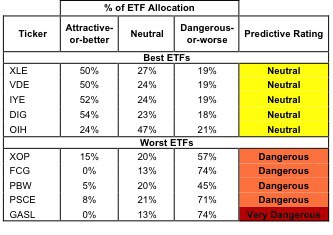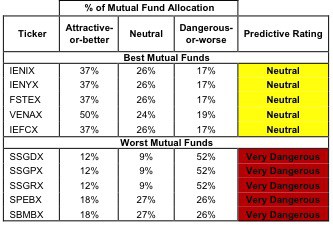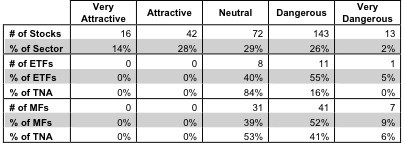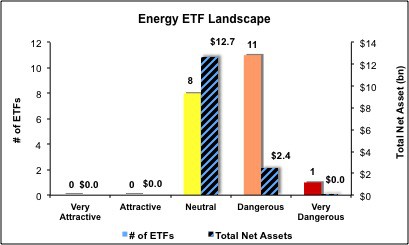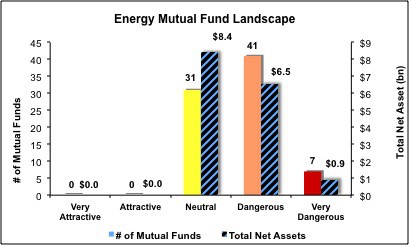The Energy sector ranks fifth out of the ten sectors as detailed in my sector rankings for ETFs and mutual funds. It gets my Neutral rating, which is based on aggregation of ratings of 20 ETFs and 79 mutual funds in the Energy sector as of October 10, 2012. Prior reports on the best & worst ETFs and mutual funds in every sector and style are here.
Figures 1 and 2 show the five best and worst-rated ETFs and mutual funds in the sector. Not all Energy sector ETFs and mutual funds are created the same. The number of holdings varies widely (from 23 to 173), which creates drastically different investment implications and ratings. The best ETFs and mutual funds allocate more value to Attractive-or-better-rated stocks than the worst ETFs and mutual funds, which allocate too much value to Neutral-or-worse-rated stocks.
To identify the best and avoid the worst ETFs and mutual funds within the Energy sector, investors need a predictive rating based on (1) stocks ratings of the holdings and (2) the all-in expenses of each ETF and mutual fund. Investors need not rely on backward-looking ratings. My fund rating methodology is detailed here.
Investors should not buy any Energy ETFs or mutual funds because none get an Attractive-or-better rating. If you must have exposure to this sector, you should buy a basket of Attractive-or-better rated stocks and avoid paying undeserved fund fees. Active management has a long history of not paying off.
Get my ratings on all ETFs and mutual funds in this sector on my free mutual fund and ETF screener.
Figure 1: ETFs with the Best & Worst Ratings – Top 5
* Best ETFs exclude ETFs with TNA’s less than 100 million for inadequate liquidity.
Sources: New Constructs, LLC and company filings
PowerShares Dynamic Energy E&P PXE is excluded from Figure 1 because its total net assets (TNA) are below $100 million and do not meet our liquidity standards.
Figure 2: Mutual Funds with the Best & Worst Ratings – Top 5
* Best mutual funds exclude funds with TNA’s less than 100 million for inadequate liquidity.
Sources: New Constructs, LLC and company filings
ICON Funds: ICON Energy Fund ICENX and ICEEX is excluded from Figure 2 because its total net assets (TNA) are below $100 million and do not meet our liquidity standards.
Energy Select Sector SPDR XLE is my top-rated Energy ETF and AIM Sector Funds: Invesco Energy Fund IENIX is my top-rated Energy mutual fund. Both earn my Neutral rating.
Direxion Daily Natural Gas Related Bull 3x Shares GASL is my worst-rated Energy ETF and Saratoga Advantage Trust: Energy and Basic Materials Portfolio SBMBX is my worst-rated Energy mutual fund. Both earn my Very Dangerous rating.
Figure 3 shows that 58 out of the 286 stocks (over 42% of the total net assets) held by Energy ETFs and mutual funds get an Attractive-or-better rating. However, no Energy ETFs or Energy mutual funds get an Attractive-or-better rating.
The takeaways are: mutual fund managers allocate too much capital to low-quality stocks and Energy ETFs hold poor quality stocks.
Figure 3: Energy Sector Landscape For ETFs, Mutual Funds & Stocks
As detailed in “Cheap Funds Dupe Investors”, the fund industry offers many cheap funds but very few funds with high-quality stocks, or with what I call good portfolio management.
Investors need to tread carefully when considering Energy ETFs and mutual funds, as no ETFs or Energy mutual funds in the Energy sector allocate enough value to Attractive-or-better-rated stocks to earn an Attractive rating. Focus on individual stocks instead.
Chevron Corporation CVX is one of my favorite stocks held by Energy ETFs and mutual funds and earns my Attractive rating. CVX currently trades at a steep discount to its no-growth value; its price-to-economic book value is .60, which implies that the market believes CVX’s profitability will permanently decline by 40%. Over the past ten years, CVX’s invested capital has grown 131%. At the same time, CVX’s NOPAT has grown 397%. Growth in operating profits (NOPAT) coupled with asset efficiency creates value for equity holders. Rather than investing in an energy fund where only a portion of the investment will go towards Attractive stocks like CVX, investors should focus on allocating to the specific stocks that earn an Attractive or better rating.
Range Resources Corp RRC is one of my least favorite stocks held by Energy ETFs and mutual funds and earns my Dangerous rating. RRC’s ROIC of 3.5% places it in the bottom third of the 3000+ companies we cover. This relatively low ROIC means RRC has had a negative economic earnings margin twelve out of the past fourteen years. To justify RRC’s current stock price, RRC must grow its NOPAT 20% compounded annually for the next 25 years. These high market expectations along with low real earnings power make RRC a Dangerous stock.
170 stocks of the 3000+ I cover are classified as Energy stocks, but due to style drift, Energy ETFs and mutual funds hold 286 stocks.
Figures 4 and 5 show the rating landscape of all Energy ETFs and mutual funds.
Our Sector Rankings for ETFs & Mutual Funds report ranks all sectors and highlights those that offer the best investments.
Figure 4: Separating the Best ETFs From the Worst ETFs
Figure 5: Separating the Best Mutual Funds From the Worst Mutual Funds
Review my full list of ratings and rankings along with reports on all 20 ETFs and 79 mutual funds in the Energy sector.
Disclosure: I receive no compensation to write about any specific stock, sector or theme.
© 2025 Benzinga.com. Benzinga does not provide investment advice. All rights reserved.
Trade confidently with insights and alerts from analyst ratings, free reports and breaking news that affects the stocks you care about.
